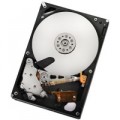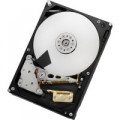Features
The general purpose of a hard drive is the type of devices for which it was originally intended.
—
For PC. Hard drives designed for use with conventional consumer computers and laptops. At the same time, the possibility of installing an internal HDD (see "Performance") directly depends on the form factor (see the relevant paragraph), while external models are not subject to such restrictions — it is enough for them to have the appropriate connection connector. Also note that almost all external hard drives are designed specifically for PCs; making server models external is not technically justified.
—
For the server. Hard drives designed for servers have increased speed and reliability, because they constantly have to receive and give large amounts of information. To ensure speed, they may provide an increased rotation speed (up to 15,000 rpm). Such drives are made only internal (see "Performance"), and, in addition to SATA, they can use other, more specific connection methods — for example,
SAS(see "Connection interfaces").
—
For game console. Specialized hard drives designed for use with game consoles. They are made only external (see "Performance"), they are intended mainly for storing games — including saves and user settings profiles. The main difference between such devices and classic external HDDs is
...precisely the optimization for working with game consoles, including the availability of special software tools for improved integration. Many of these drives are originally designed for a specific model or family of set-top boxes.Connection
— SATA. Nowadays, it is the most popular interface for connecting internal hard drives.
the first version of SATA provides a data transfer speed of about 1.2 Gbit/s,
SATA 2 has a practical data transfer speed of about 2.4 Gbit/s (300 MB/s), and the most advanced generation
of SATA 3 has a speed of 4.8 Gbit/s (600 MB/s)
- eSATA. Modification of the SATA interface designed for connecting external hard drives; not compatible with internal SATA. Practical data transfer speed is similar to SATA 2 and is about 2.4 Gbps (300 MB/s).
- SAS. Modification of the SCSI interface provides data transfer speeds up to 6 Gbit/s (750 Mb/s). It is used mainly in servers; it is practically never used in desktop PCs and laptops.
-
USB 2.0. The earliest of the USB standards found in modern hard drives - and exclusively external ones (see “Execution”). Provides connection to a traditional full-size USB port, provides data transfer speeds of up to 480 Mbit/s, as well as fairly low power supply, which is why drives with this type of connection often require additional power. In light of all this, as well as the emergence of the more advanced USB 3.2 standard (see below), today USB 2.0 is considered obsolete and is extremely rare, mainly in inexpensive and early models of drives. However, a disk with this interface can also be connected to a n
...ewer USB port - the main thing is that the connectors match.
— USB 3.2 gen1(previous names USB 3.1 gen1 and USB 3.0). A standard for connecting external HDDs, which replaced the USB 2.0 described above. Uses a traditional full-size USB connector, provides data transfer speeds of up to 4.8 Gbps (600 MB/s), as well as higher power supply, making it easier to do without external power in such drives. However, for the same reason, you need to be careful when connecting USB 3.2 gen1 drives to older USB 2.0 connectors - such a connector may not have enough power to power a newer drive.
- USB 3.2 gen2. Further development of the USB 3.2 standard (previously known as USB 3.1 gen2 and USB 3.1). The maximum data transfer rate in this version has been increased to 10 Gbps, and the power supply can reach 100 W (with support for USB Power Delivery technology). At the same time, drives with this type of connection can also work with earlier versions of full-size USB connectors - the main thing is that there is enough power supply.
— USB C 3.2 gen1(previous names USB C 3.1 gen1 and USB C 3.0). Connection via USB C connector, corresponding to USB 3.2 gen1 capabilities. These capabilities are described in more detail above; the difference from the “regular” USB 3.2 gen1 in this case lies only in the type of connector: it is a relatively small (slightly larger than microUSB) socket, which also has a double-sided design. Thanks to its compact size, USB C is found both in full-size PCs and laptops, as well as in compact gadgets like smartphones and tablets; Some drives with this connection initially allow “mobile” use.
— USB C 3.2 gen2(previous names USB C 3.1 gen2 and USB C 3.1). Update and improvement of the USB C 3.2 gen1 described above - the same USB C connector and increased data transfer speed to 10 Gbps (as in the “regular” USB 3.2 gen2).
- Thunderbolt. High-speed interface for connecting external peripherals. It is used mainly in Apple computers and laptops, although it is also found in equipment from other manufacturers. Note that in modern HDDs there are mainly two versions of Thunderbolt, which differ not only in operating speed, but also in connector: Thunderbolt v2(up to 20 Gbps) uses a miniDisplayPort plug, and Thunderbolt v3(up to 40 Gbps) — USB C plug (see above). In light of this, some hard drives implement USB C and Thunderbolt connections through a single hardware connector, which automatically detects which computer input the device is connected to.Manufacturer's warranty
Manufacturer's warranty provided for this model.
In fact, this is the minimum service life promised by the manufacturer, subject to the rules of operation. Most often, the actual service life of the device is much longer than the guaranteed one.
RPM
For drives used in a PC (see "Intended use"),
5400 rpm(normal) and
7200 rpm(high) are considered standard speeds. There are also
more specific options, including models with the ability to adjust the speed depending on the load. In server HDDs, in turn, higher speeds can be used —
10,000 rpm and even
15,000 rpm.
Average search time
The time it takes for the hard disk mechanics to find random requested data to read. For each specific case, the search time is different, as it depends on the location of the data on the surface of the disk and the position of the read head, therefore, the average value is indicated in the characteristics of hard drives. The lower the average seek time, the faster the disk works, all other things being equal.
Standby power consumption
The amount of power consumed by the disk "idle". In the on state, the disk platters rotate regardless of whether information is being written or read or not — maintaining this rotation takes the energy consumed while waiting.
The lower the power consumption while waiting, the more economical the disk is, the less energy it consumes. At the same time, we note that in fact this parameter is relevant mainly when choosing a drive for a laptop, when energy efficiency is crucial. For stationary PCs, “idle” power consumption does not play a special role, and when calculating the requirements for a power supply, it is necessary to take into account not this indicator, but the power consumption during operation (see above).
Shockproof
A parameter that determines the resistance of the hard drive to drops and shocks during operation (that is, in the on state). Shock resistance is measured in G — units of overload, 1 G corresponds to the usual force of gravity. The higher the G number, the more resistant the disc is to various kinds of concussions and the less likely it is to be damaged, say, in the event of a fall. This setting is especially important for external drives and drives used in laptops.
Standby mode noise level
The amount of noise produced by a disk "idle", when no read and/or write operations are performed. The sound source in this case is the plates — they rotate all the time while the disk is on; since no other mechanics are involved, idle noise is generally lower than read/write noise. The lower the noise level, the more comfortable the use of the device. The maximum noise level of modern hard drives in standby mode is about 40 dB — this is comparable to quiet human speech.
MTBF
Guaranteed (minimum) hard drive uptime. The longer the time between failures, the more durable and reliable the device. At the same time, we note that after this time, the drive will not necessarily fail immediately — most models remain operational even after the claimed resource has been exhausted, but the manufacturer does not give any guarantees here.

